check transmission fluid FORD RANGER 2003 2.G Owners Manual
[x] Cancel search | Manufacturer: FORD, Model Year: 2003, Model line: RANGER, Model: FORD RANGER 2003 2.GPages: 248, PDF Size: 2.53 MB
Page 114 of 248
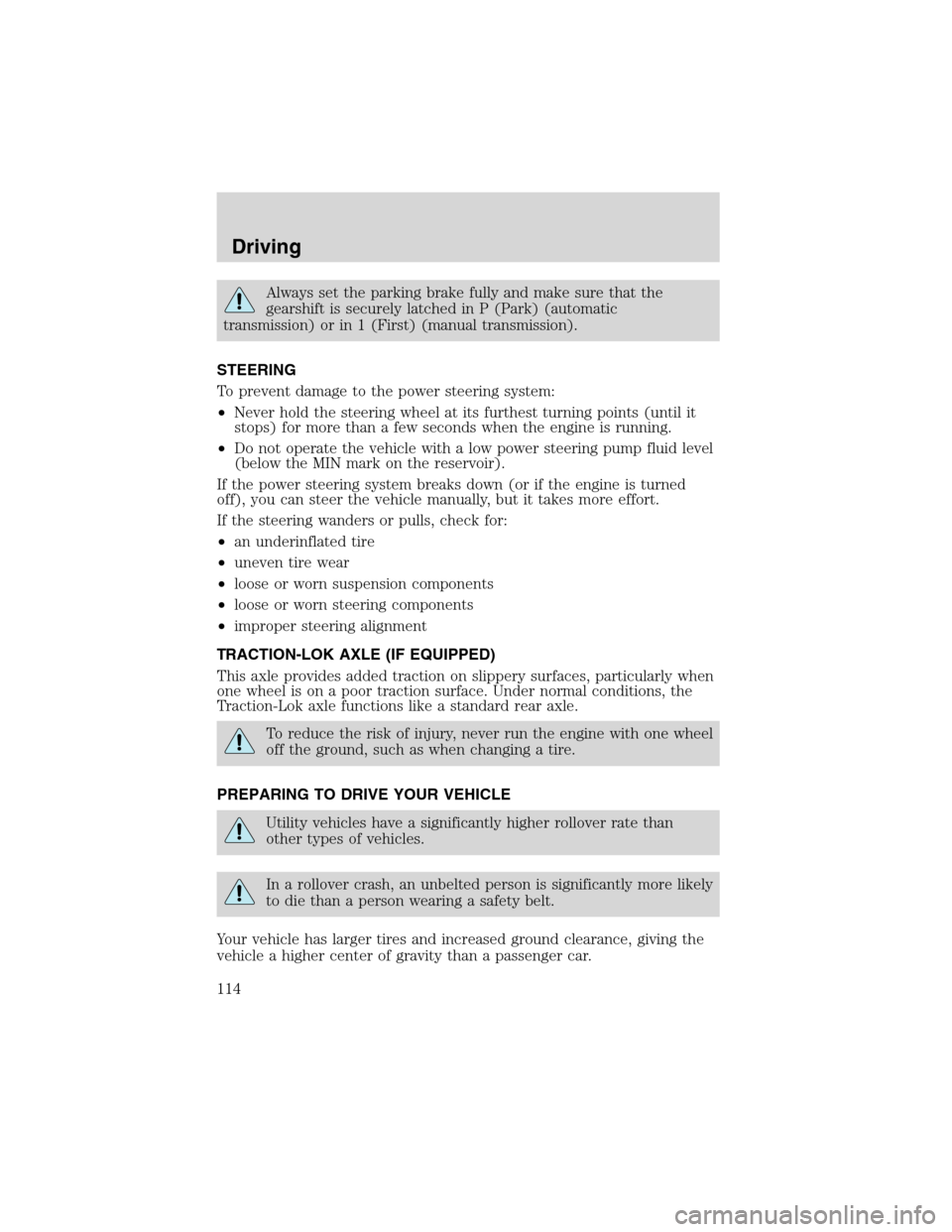
Always set the parking brake fully and make sure that the
gearshift is securely latched in P (Park) (automatic
transmission) or in 1 (First) (manual transmission).
STEERING
To prevent damage to the power steering system:
•Never hold the steering wheel at its furthest turning points (until it
stops) for more than a few seconds when the engine is running.
•Do not operate the vehicle with a low power steering pump fluid level
(below the MIN mark on the reservoir).
If the power steering system breaks down (or if the engine is turned
off), you can steer the vehicle manually, but it takes more effort.
If the steering wanders or pulls, check for:
•an underinflated tire
•uneven tire wear
•loose or worn suspension components
•loose or worn steering components
•improper steering alignment
TRACTION-LOK AXLE (IF EQUIPPED)
This axle provides added traction on slippery surfaces, particularly when
one wheel is on a poor traction surface. Under normal conditions, the
Traction-Lok axle functions like a standard rear axle.
To reduce the risk of injury, never run the engine with one wheel
off the ground, such as when changing a tire.
PREPARING TO DRIVE YOUR VEHICLE
Utility vehicles have a significantly higher rollover rate than
other types of vehicles.
In a rollover crash, an unbelted person is significantly more likely
to die than a person wearing a safety belt.
Your vehicle has larger tires and increased ground clearance, giving the
vehicle a higher center of gravity than a passenger car.
Driving
114
Page 127 of 248
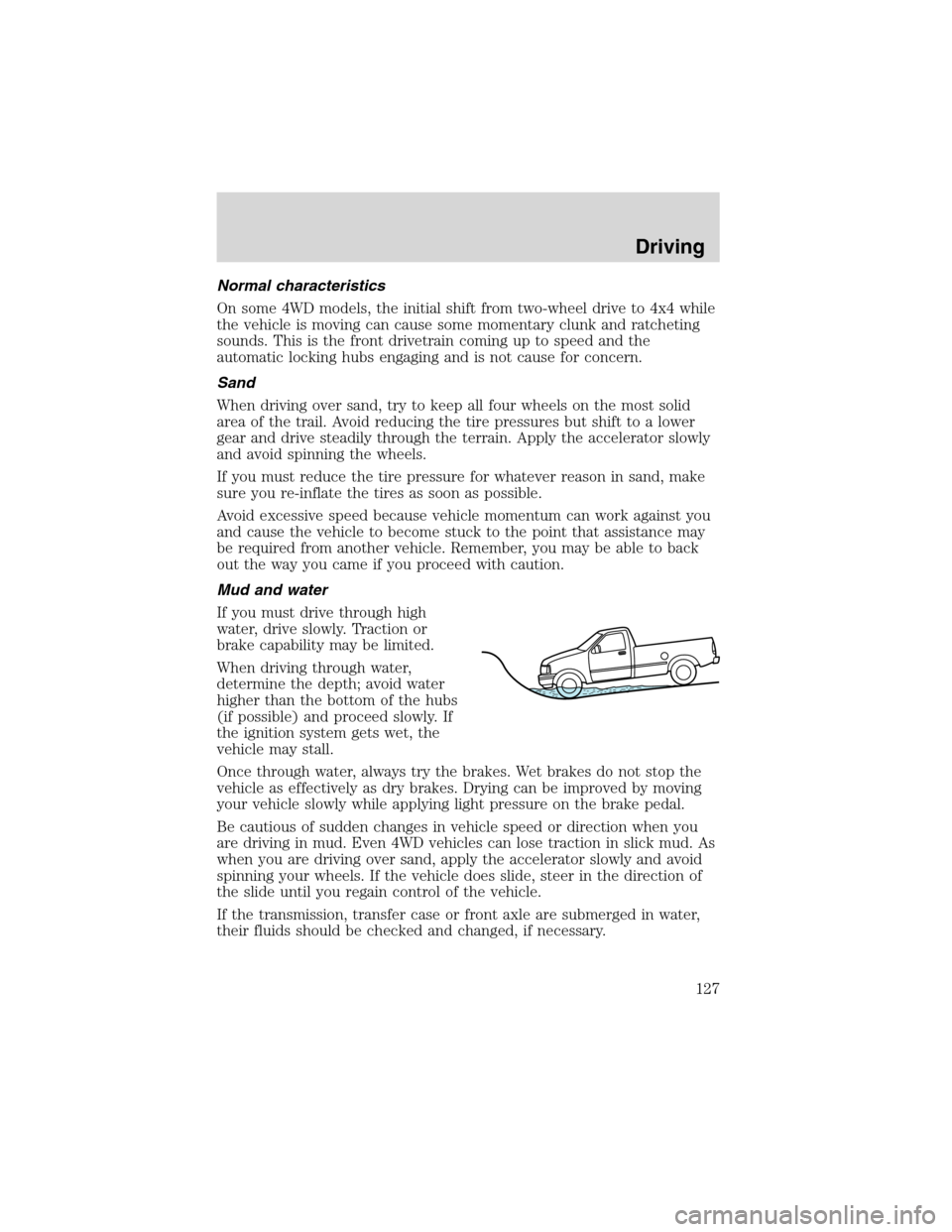
Normal characteristics
On some 4WD models, the initial shift from two-wheel drive to 4x4 while
the vehicle is moving can cause some momentary clunk and ratcheting
sounds. This is the front drivetrain coming up to speed and the
automatic locking hubs engaging and is not cause for concern.
Sand
When driving over sand, try to keep all four wheels on the most solid
area of the trail. Avoid reducing the tire pressures but shift to a lower
gear and drive steadily through the terrain. Apply the accelerator slowly
and avoid spinning the wheels.
If you must reduce the tire pressure for whatever reason in sand, make
sure you re-inflate the tires as soon as possible.
Avoid excessive speed because vehicle momentum can work against you
and cause the vehicle to become stuck to the point that assistance may
be required from another vehicle. Remember, you may be able to back
out the way you came if you proceed with caution.
Mud and water
If you must drive through high
water, drive slowly. Traction or
brake capability may be limited.
When driving through water,
determine the depth; avoid water
higher than the bottom of the hubs
(if possible) and proceed slowly. If
the ignition system gets wet, the
vehicle may stall.
Once through water, always try the brakes. Wet brakes do not stop the
vehicle as effectively as dry brakes. Drying can be improved by moving
your vehicle slowly while applying light pressure on the brake pedal.
Be cautious of sudden changes in vehicle speed or direction when you
are driving in mud. Even 4WD vehicles can lose traction in slick mud. As
when you are driving over sand, apply the accelerator slowly and avoid
spinning your wheels. If the vehicle does slide, steer in the direction of
the slide until you regain control of the vehicle.
If the transmission, transfer case or front axle are submerged in water,
their fluids should be checked and changed, if necessary.
Driving
127
Page 187 of 248
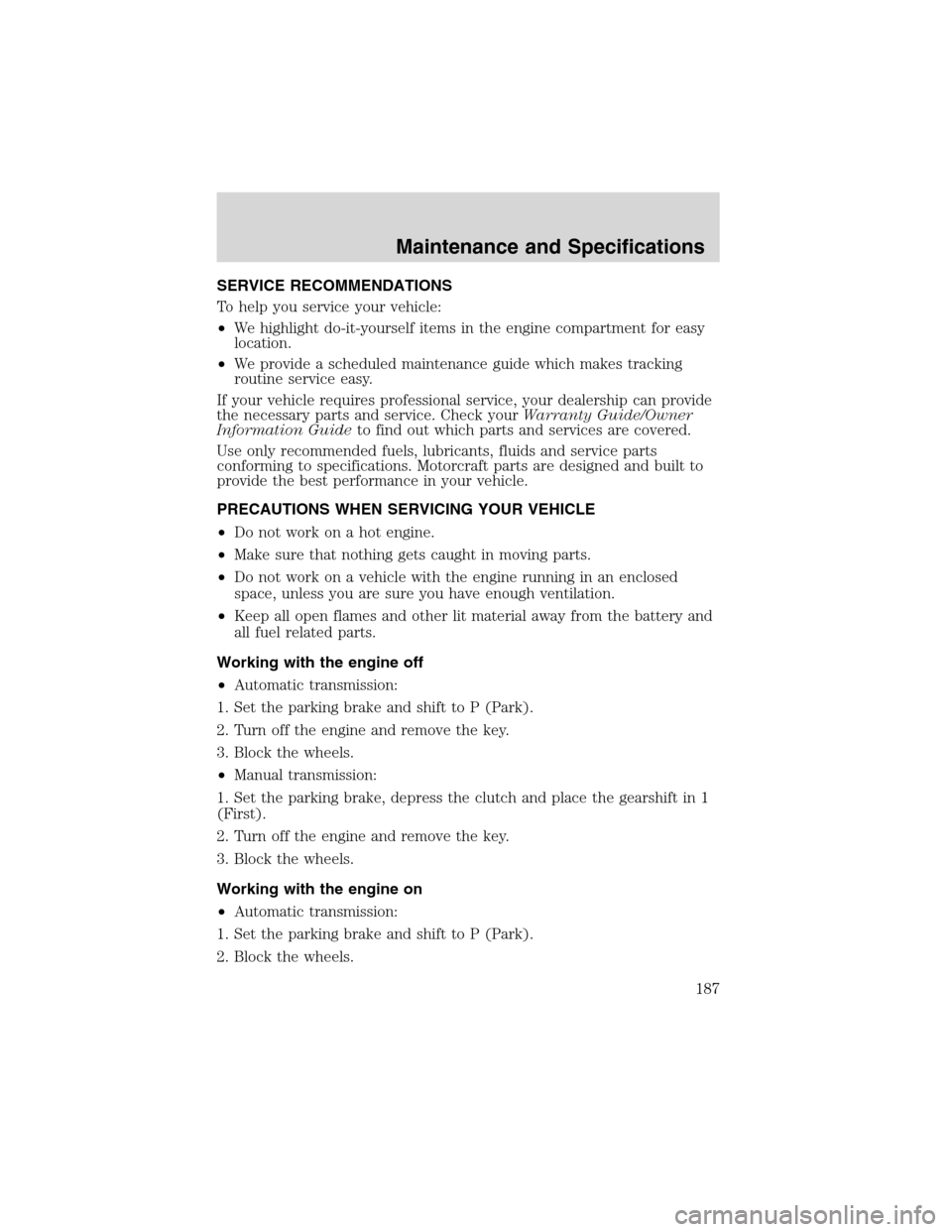
SERVICE RECOMMENDATIONS
To help you service your vehicle:
•We highlight do-it-yourself items in the engine compartment for easy
location.
•We provide a scheduled maintenance guide which makes tracking
routine service easy.
If your vehicle requires professional service, your dealership can provide
the necessary parts and service. Check yourWarranty Guide/Owner
Information Guideto find out which parts and services are covered.
Use only recommended fuels, lubricants, fluids and service parts
conforming to specifications. Motorcraft parts are designed and built to
provide the best performance in your vehicle.
PRECAUTIONS WHEN SERVICING YOUR VEHICLE
•Do not work on a hot engine.
•Make sure that nothing gets caught in moving parts.
•Do not work on a vehicle with the engine running in an enclosed
space, unless you are sure you have enough ventilation.
•Keep all open flames and other lit material away from the battery and
all fuel related parts.
Working with the engine off
•Automatic transmission:
1. Set the parking brake and shift to P (Park).
2. Turn off the engine and remove the key.
3. Block the wheels.
•Manual transmission:
1. Set the parking brake, depress the clutch and place the gearshift in 1
(First).
2. Turn off the engine and remove the key.
3. Block the wheels.
Working with the engine on
•Automatic transmission:
1. Set the parking brake and shift to P (Park).
2. Block the wheels.
Maintenance and Specifications
187
Page 192 of 248
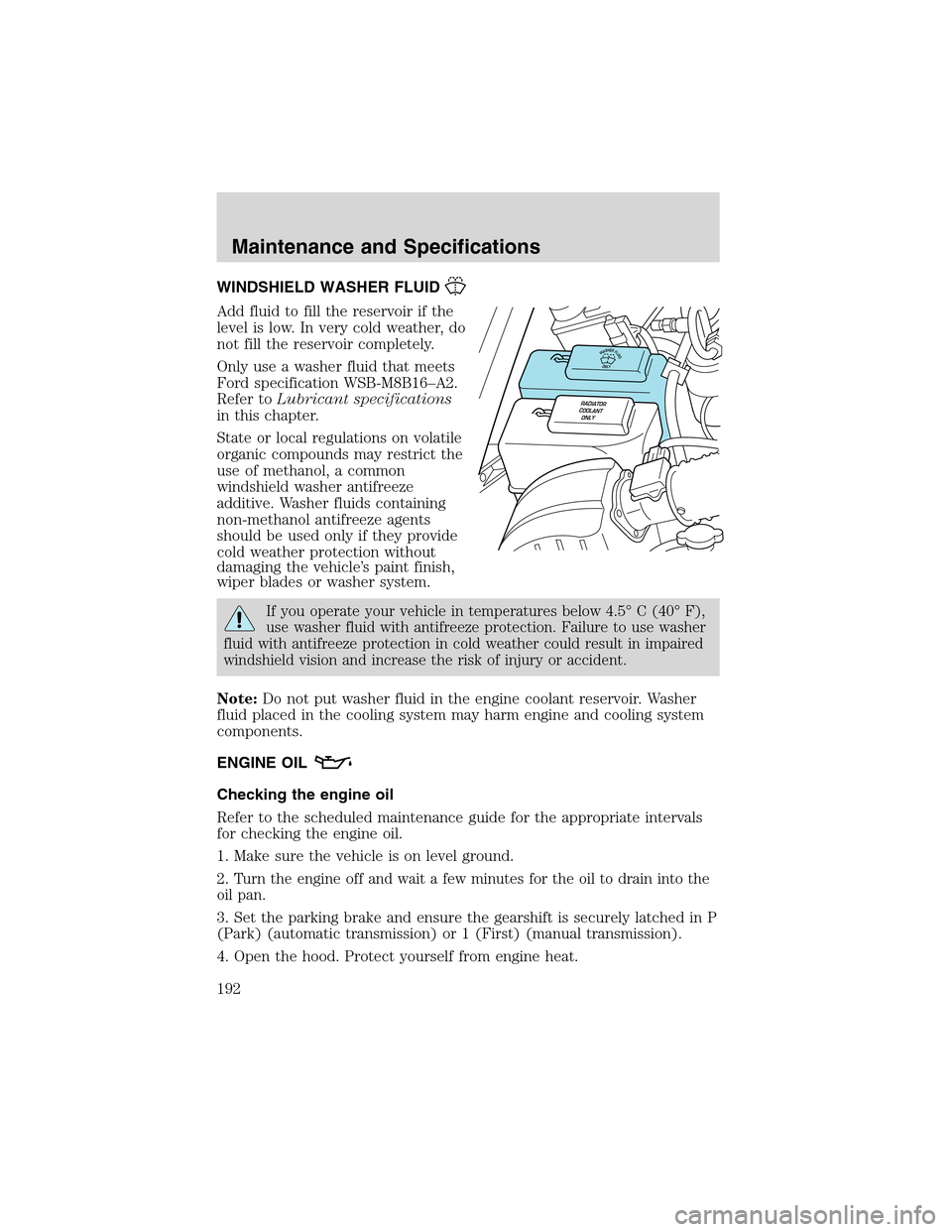
WINDSHIELD WASHER FLUID
Add fluid to fill the reservoir if the
level is low. In very cold weather, do
not fill the reservoir completely.
Only use a washer fluid that meets
Ford specification WSB-M8B16–A2.
Refer toLubricant specifications
in this chapter.
State or local regulations on volatile
organic compounds may restrict the
use of methanol, a common
windshield washer antifreeze
additive. Washer fluids containing
non-methanol antifreeze agents
should be used only if they provide
cold weather protection without
damaging the vehicle’s paint finish,
wiper blades or washer system.
If you operate your vehicle in temperatures below 4.5°C (40°F),
use washer fluid with antifreeze protection. Failure to use washer
fluid with antifreeze protection in cold weather could result in impaired
windshield vision and increase the risk of injury or accident.
Note:Do not put washer fluid in the engine coolant reservoir. Washer
fluid placed in the cooling system may harm engine and cooling system
components.
ENGINE OIL
Checking the engine oil
Refer to the scheduled maintenance guide for the appropriate intervals
for checking the engine oil.
1. Make sure the vehicle is on level ground.
2.
Turn the engine off and wait a few minutes for the oil to drain into the
oil pan.
3. Set the parking brake and ensure the gearshift is securely latched in P
(Park) (automatic transmission) or 1 (First) (manual transmission).
4. Open the hood. Protect yourself from engine heat.
WASHERFLUIDONLY
RADIATOR
COOLANT
ONLY
Maintenance and Specifications
192
Page 219 of 248
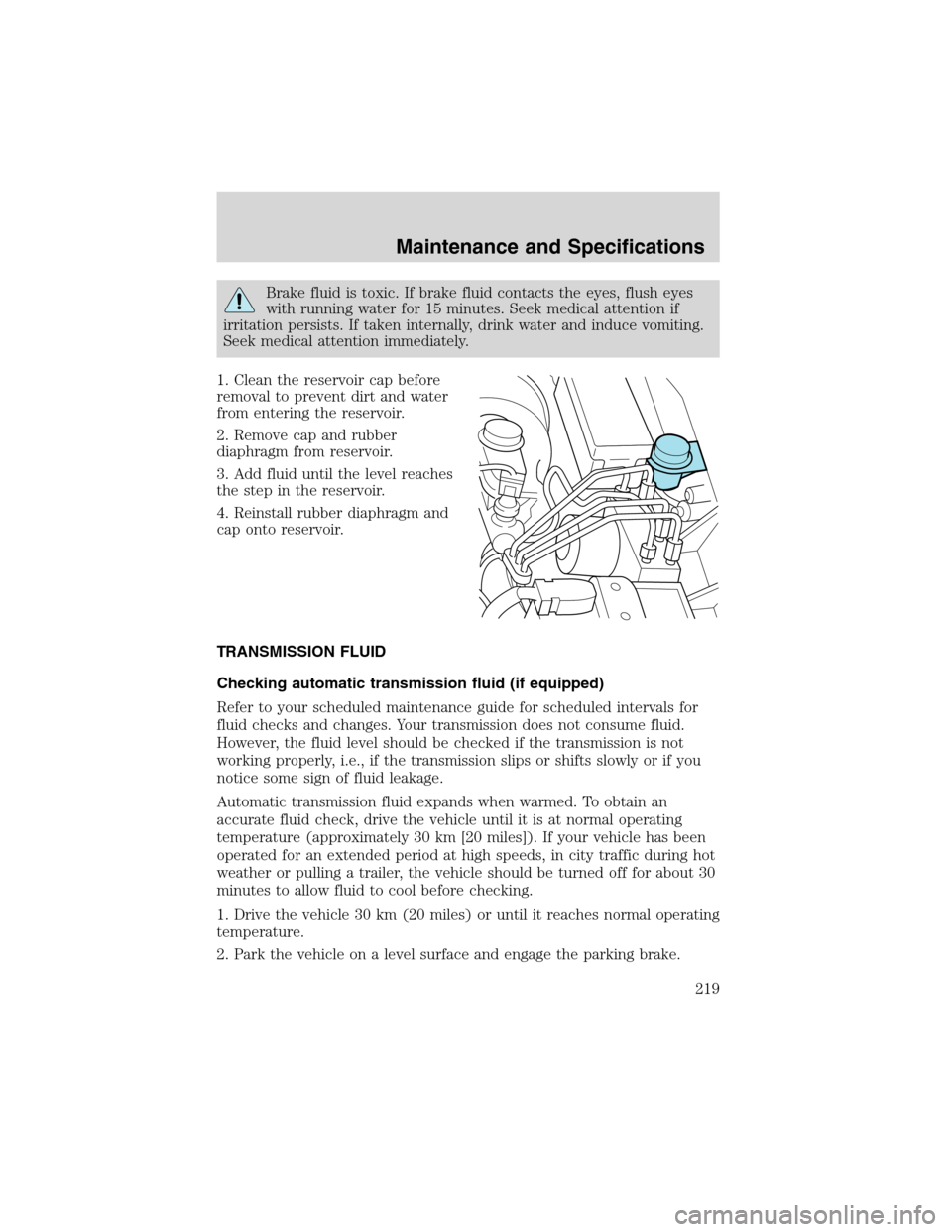
Brake fluid is toxic. If brake fluid contacts the eyes, flush eyes
with running water for 15 minutes. Seek medical attention if
irritation persists. If taken internally, drink water and induce vomiting.
Seek medical attention immediately.
1. Clean the reservoir cap before
removal to prevent dirt and water
from entering the reservoir.
2. Remove cap and rubber
diaphragm from reservoir.
3. Add fluid until the level reaches
the step in the reservoir.
4. Reinstall rubber diaphragm and
cap onto reservoir.
TRANSMISSION FLUID
Checking automatic transmission fluid (if equipped)
Refer to your scheduled maintenance guide for scheduled intervals for
fluid checks and changes. Your transmission does not consume fluid.
However, the fluid level should be checked if the transmission is not
working properly, i.e., if the transmission slips or shifts slowly or if you
notice some sign of fluid leakage.
Automatic transmission fluid expands when warmed. To obtain an
accurate fluid check, drive the vehicle until it is at normal operating
temperature (approximately 30 km [20 miles]). If your vehicle has been
operated for an extended period at high speeds, in city traffic during hot
weather or pulling a trailer, the vehicle should be turned off for about 30
minutes to allow fluid to cool before checking.
1. Drive the vehicle 30 km (20 miles) or until it reaches normal operating
temperature.
2. Park the vehicle on a level surface and engage the parking brake.
Maintenance and Specifications
219
Page 220 of 248
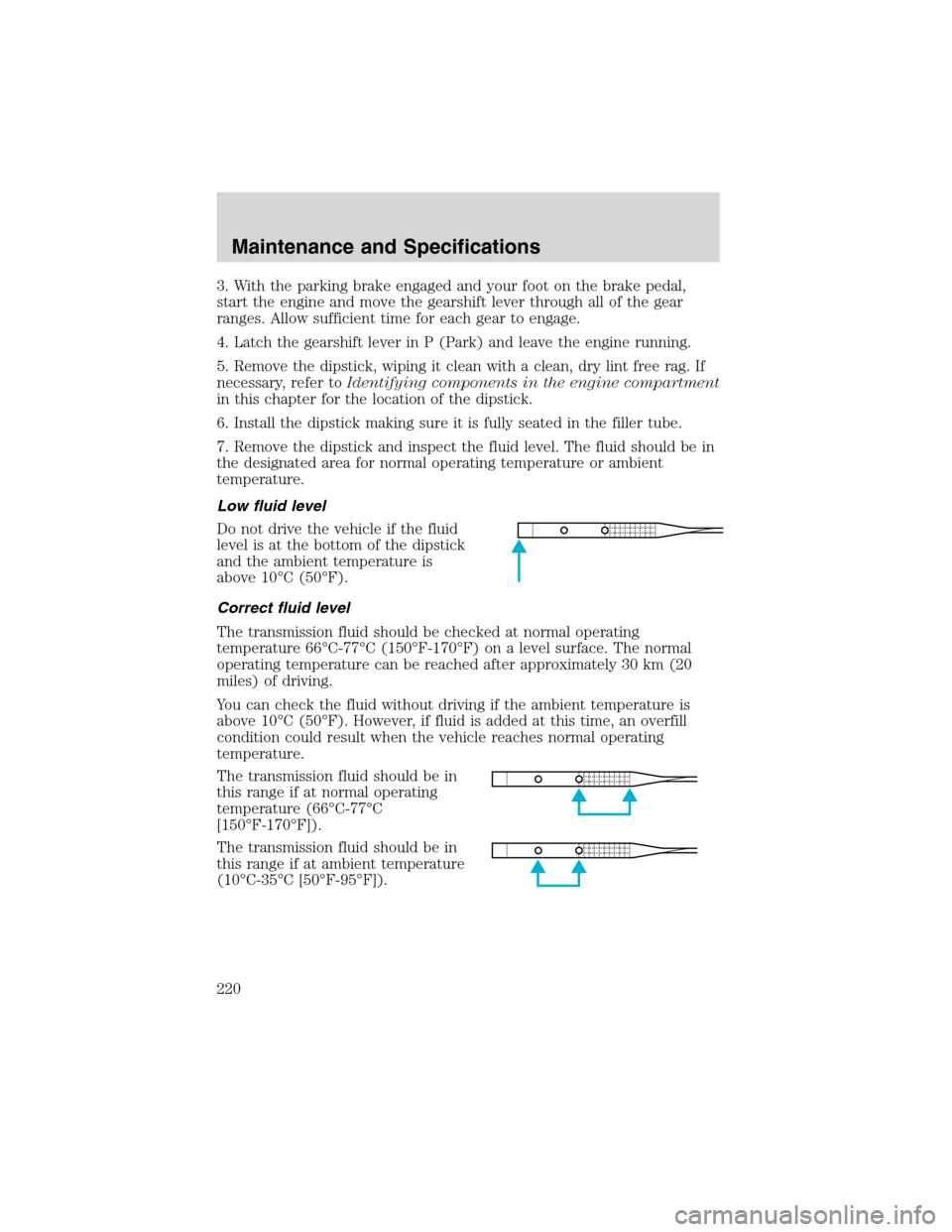
3. With the parking brake engaged and your foot on the brake pedal,
start the engine and move the gearshift lever through all of the gear
ranges. Allow sufficient time for each gear to engage.
4. Latch the gearshift lever in P (Park) and leave the engine running.
5. Remove the dipstick, wiping it clean with a clean, dry lint free rag. If
necessary, refer toIdentifying components in the engine compartment
in this chapter for the location of the dipstick.
6. Install the dipstick making sure it is fully seated in the filler tube.
7. Remove the dipstick and inspect the fluid level. The fluid should be in
the designated area for normal operating temperature or ambient
temperature.
Low fluid level
Do not drive the vehicle if the fluid
level is at the bottom of the dipstick
and the ambient temperature is
above 10°C (50°F).
Correct fluid level
The transmission fluid should be checked at normal operating
temperature 66°C-77°C (150°F-170°F) on a level surface. The normal
operating temperature can be reached after approximately 30 km (20
miles) of driving.
You can check the fluid without driving if the ambient temperature is
above 10°C (50°F). However, if fluid is added at this time, an overfill
condition could result when the vehicle reaches normal operating
temperature.
The transmission fluid should be in
this range if at normal operating
temperature (66°C-77°C
[150°F-170°F]).
The transmission fluid should be in
this range if at ambient temperature
(10°C-35°C [50°F-95°F]).
Maintenance and Specifications
220
Page 222 of 248
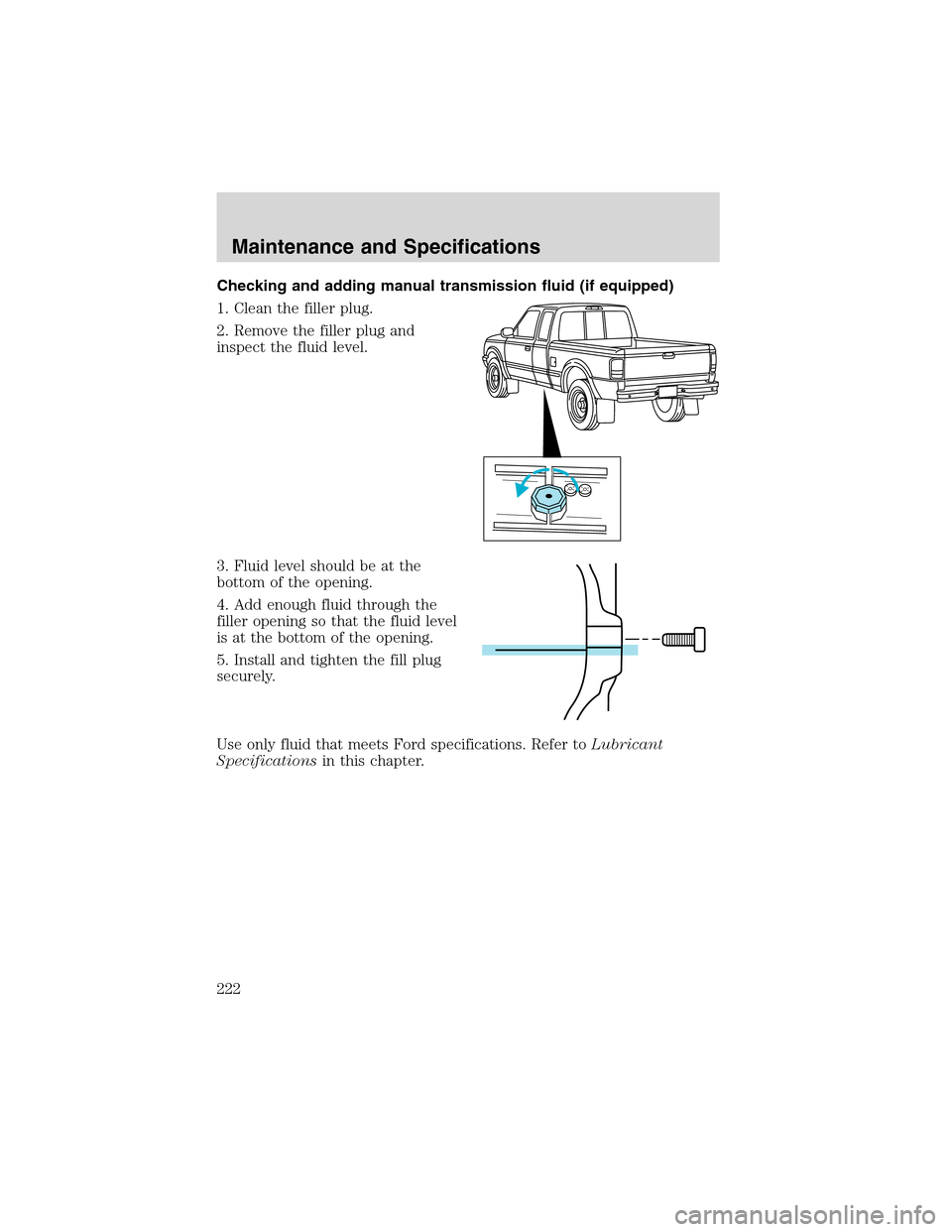
Checking and adding manual transmission fluid (if equipped)
1. Clean the filler plug.
2. Remove the filler plug and
inspect the fluid level.
3. Fluid level should be at the
bottom of the opening.
4. Add enough fluid through the
filler opening so that the fluid level
is at the bottom of the opening.
5. Install and tighten the fill plug
securely.
Use only fluid that meets Ford specifications. Refer toLubricant
Specificationsin this chapter.
Maintenance and Specifications
222
Page 243 of 248
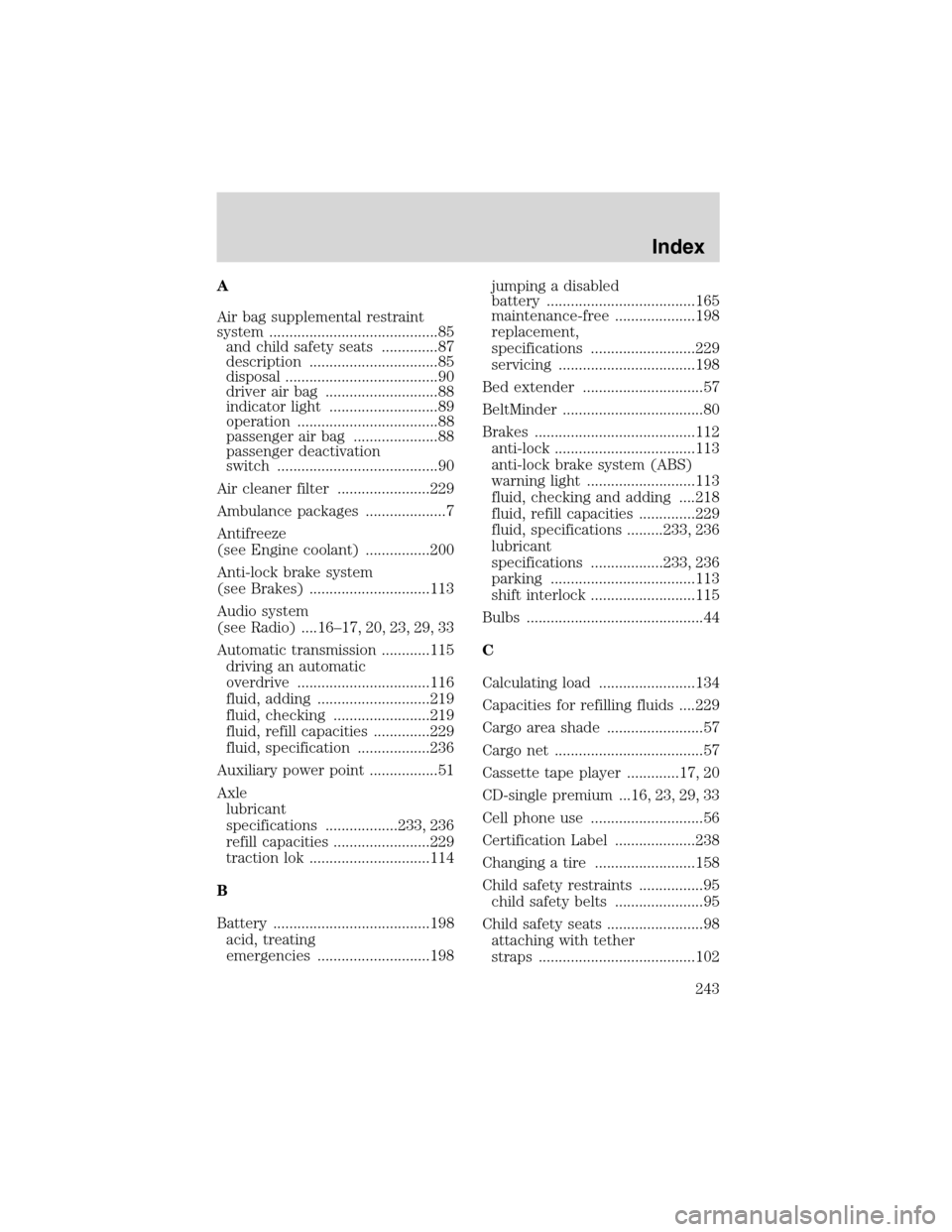
A
Air bag supplemental restraint
system ..........................................85
and child safety seats ..............87
description ................................85
disposal ......................................90
driver air bag ............................88
indicator light ...........................89
operation ...................................88
passenger air bag .....................88
passenger deactivation
switch ........................................90
Air cleaner filter .......................229
Ambulance packages ....................7
Antifreeze
(see Engine coolant) ................200
Anti-lock brake system
(see Brakes) ..............................113
Audio system
(see Radio) ....16–17, 20, 23, 29, 33
Automatic transmission ............115
driving an automatic
overdrive .................................116
fluid, adding ............................219
fluid, checking ........................219
fluid, refill capacities ..............229
fluid, specification ..................236
Auxiliary power point .................51
Axle
lubricant
specifications ..................233, 236
refill capacities ........................229
traction lok ..............................114
B
Battery .......................................198
acid, treating
emergencies ............................198jumping a disabled
battery .....................................165
maintenance-free ....................198
replacement,
specifications ..........................229
servicing ..................................198
Bed extender ..............................57
BeltMinder ...................................80
Brakes ........................................112
anti-lock ...................................113
anti-lock brake system (ABS)
warning light ...........................113
fluid, checking and adding ....218
fluid, refill capacities ..............229
fluid, specifications .........233, 236
lubricant
specifications ..................233, 236
parking ....................................113
shift interlock ..........................115
Bulbs ............................................44
C
Calculating load ........................134
Capacities for refilling fluids ....229
Cargo area shade ........................57
Cargo net .....................................57
Cassette tape player .............17, 20
CD-single premium ...16, 23, 29, 33
Cell phone use ............................56
Certification Label ....................238
Changing a tire .........................158
Child safety restraints ................95
child safety belts ......................95
Child safety seats ........................98
attaching with tether
straps .......................................102
Index
243
Page 244 of 248
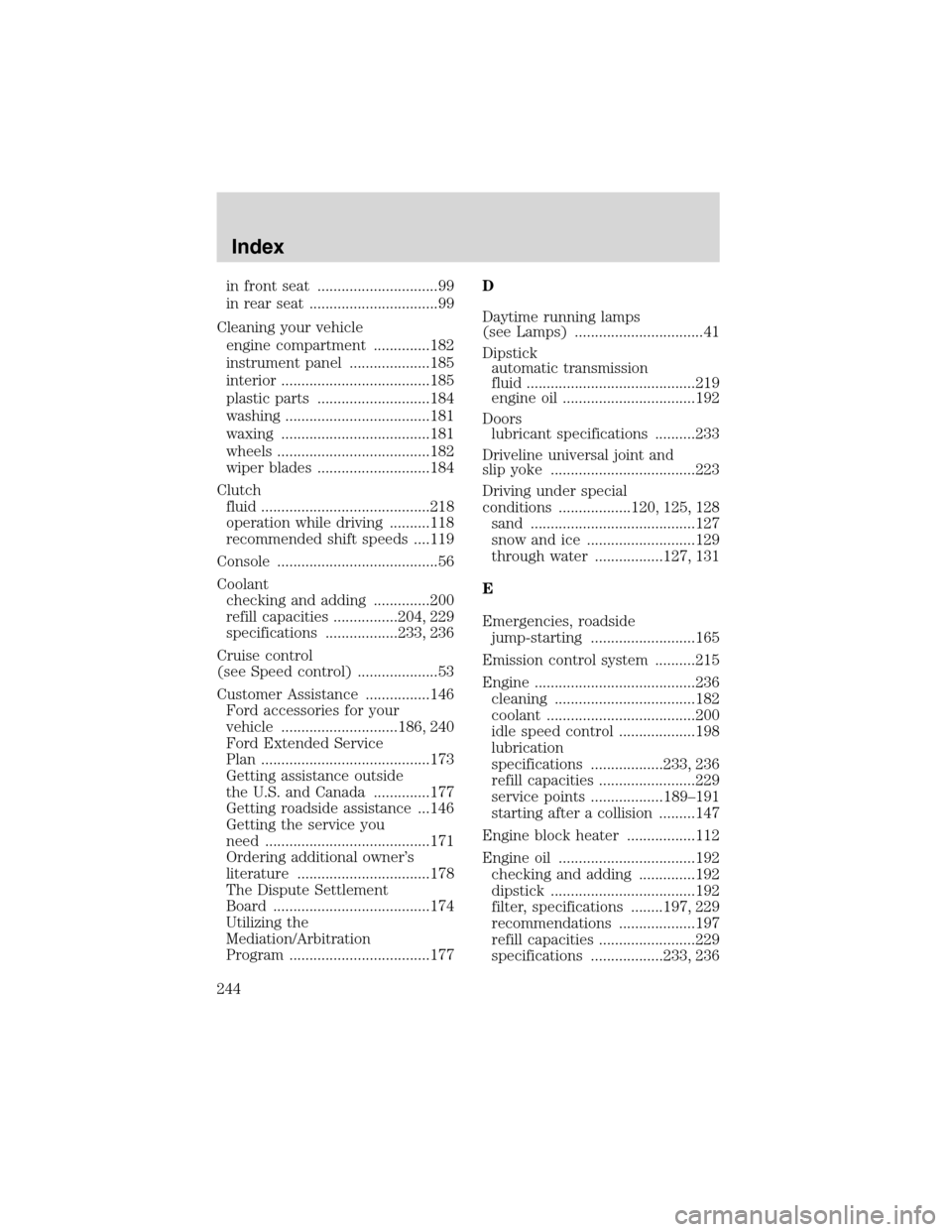
in front seat ..............................99
in rear seat ................................99
Cleaning your vehicle
engine compartment ..............182
instrument panel ....................185
interior .....................................185
plastic parts ............................184
washing ....................................181
waxing .....................................181
wheels ......................................182
wiper blades ............................184
Clutch
fluid ..........................................218
operation while driving ..........118
recommended shift speeds ....119
Console ........................................56
Coolant
checking and adding ..............200
refill capacities ................204, 229
specifications ..................233, 236
Cruise control
(see Speed control) ....................53
Customer Assistance ................146
Ford accessories for your
vehicle .............................186, 240
Ford Extended Service
Plan ..........................................173
Getting assistance outside
the U.S. and Canada ..............177
Getting roadside assistance ...146
Getting the service you
need .........................................171
Ordering additional owner’s
literature .................................178
The Dispute Settlement
Board .......................................174
Utilizing the
Mediation/Arbitration
Program ...................................177D
Daytime running lamps
(see Lamps) ................................41
Dipstick
automatic transmission
fluid ..........................................219
engine oil .................................192
Doors
lubricant specifications ..........233
Driveline universal joint and
slip yoke ....................................223
Driving under special
conditions ..................120, 125, 128
sand .........................................127
snow and ice ...........................129
through water .................127, 131
E
Emergencies, roadside
jump-starting ..........................165
Emission control system ..........215
Engine ........................................236
cleaning ...................................182
coolant .....................................200
idle speed control ...................198
lubrication
specifications ..................233, 236
refill capacities ........................229
service points ..................189–191
starting after a collision .........147
Engine block heater .................112
Engine oil ..................................192
checking and adding ..............192
dipstick ....................................192
filter, specifications ........197, 229
recommendations ...................197
refill capacities ........................229
specifications ..................233, 236
Index
244
Page 246 of 248
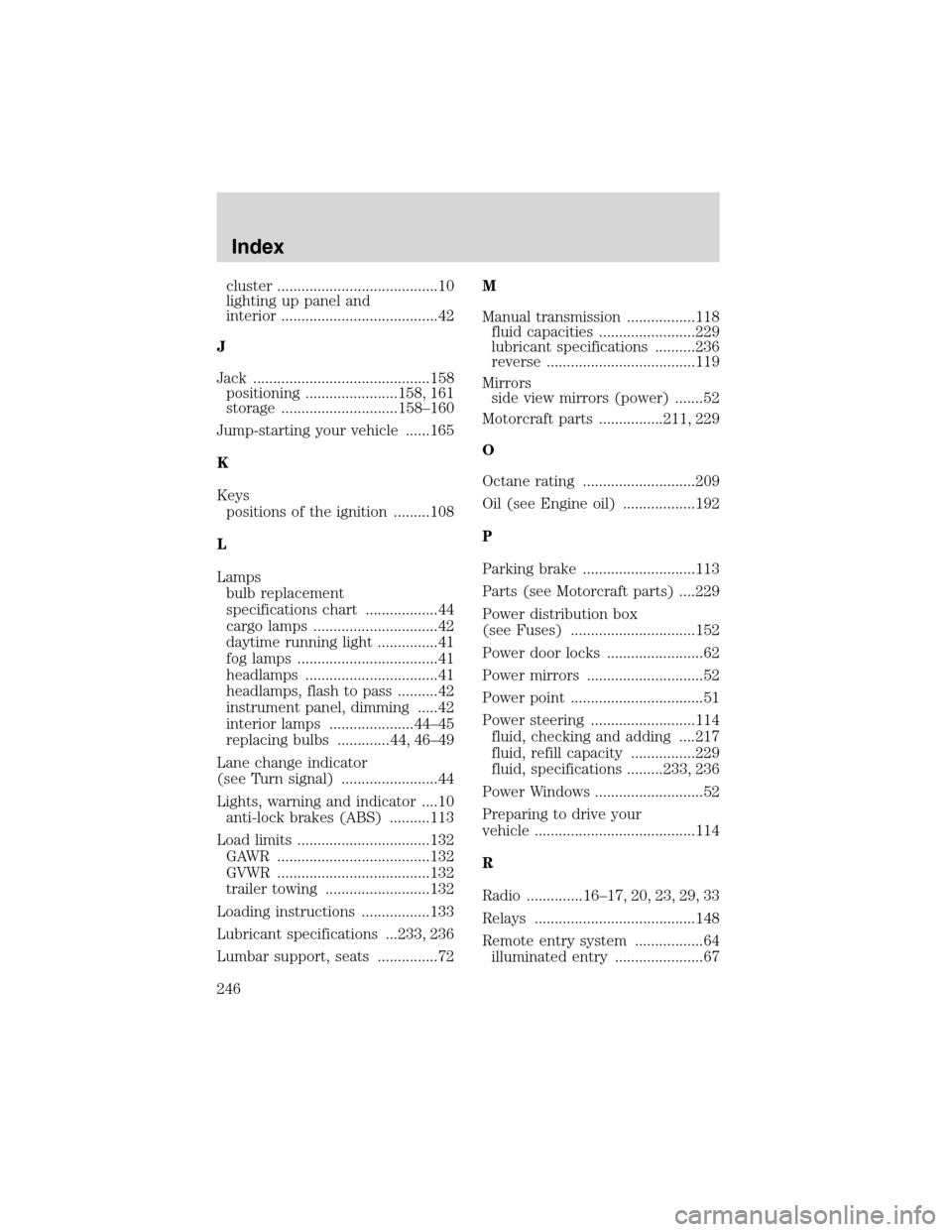
cluster ........................................10
lighting up panel and
interior .......................................42
J
Jack ............................................158
positioning .......................158, 161
storage .............................158–160
Jump-starting your vehicle ......165
K
Keys
positions of the ignition .........108
L
Lamps
bulb replacement
specifications chart ..................44
cargo lamps ...............................42
daytime running light ...............41
fog lamps ...................................41
headlamps .................................41
headlamps, flash to pass ..........42
instrument panel, dimming .....42
interior lamps .....................44–45
replacing bulbs .............44, 46–49
Lane change indicator
(see Turn signal) ........................44
Lights, warning and indicator ....10
anti-lock brakes (ABS) ..........113
Load limits .................................132
GAWR ......................................132
GVWR ......................................132
trailer towing ..........................132
Loading instructions .................133
Lubricant specifications ...233, 236
Lumbar support, seats ...............72M
Manual transmission .................118
fluid capacities ........................229
lubricant specifications ..........236
reverse .....................................119
Mirrors
side view mirrors (power) .......52
Motorcraft parts ................211, 229
O
Octane rating ............................209
Oil (see Engine oil) ..................192
P
Parking brake ............................113
Parts (see Motorcraft parts) ....229
Power distribution box
(see Fuses) ...............................152
Power door locks ........................62
Power mirrors .............................52
Power point .................................51
Power steering ..........................114
fluid, checking and adding ....217
fluid, refill capacity ................229
fluid, specifications .........233, 236
Power Windows ...........................52
Preparing to drive your
vehicle ........................................114
R
Radio ..............16–17, 20, 23, 29, 33
Relays ........................................148
Remote entry system .................64
illuminated entry ......................67
Index
246